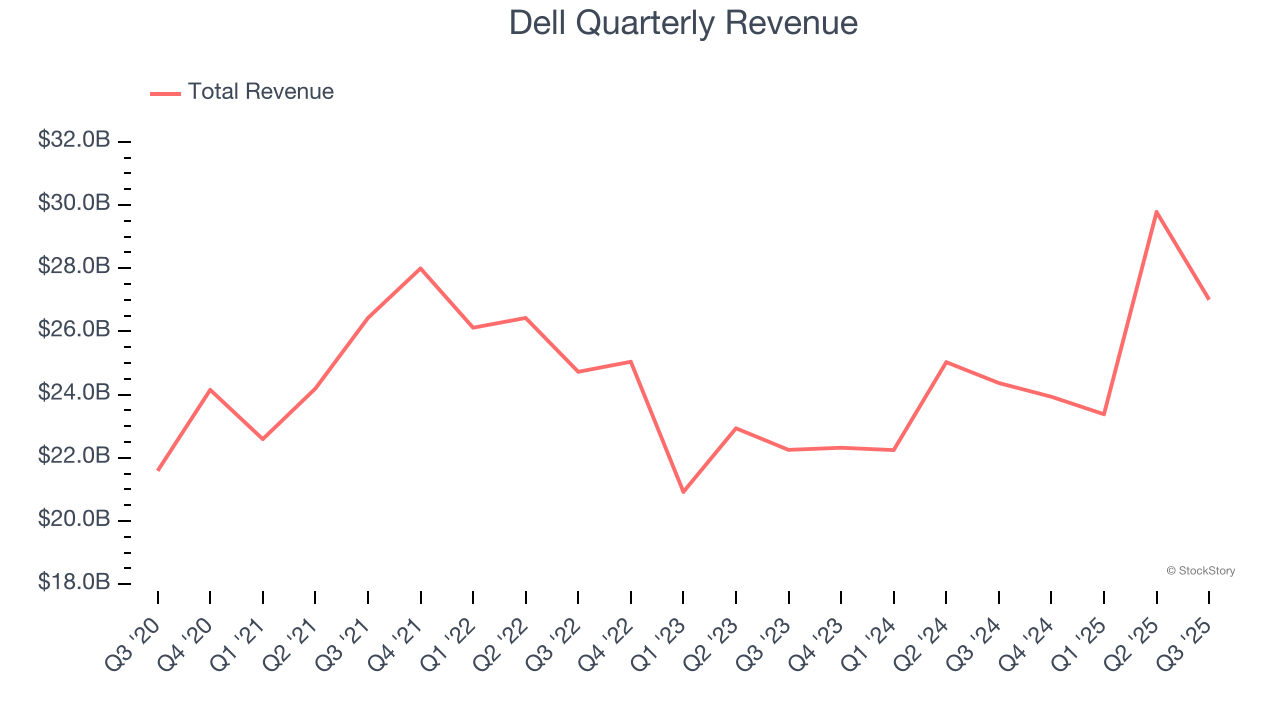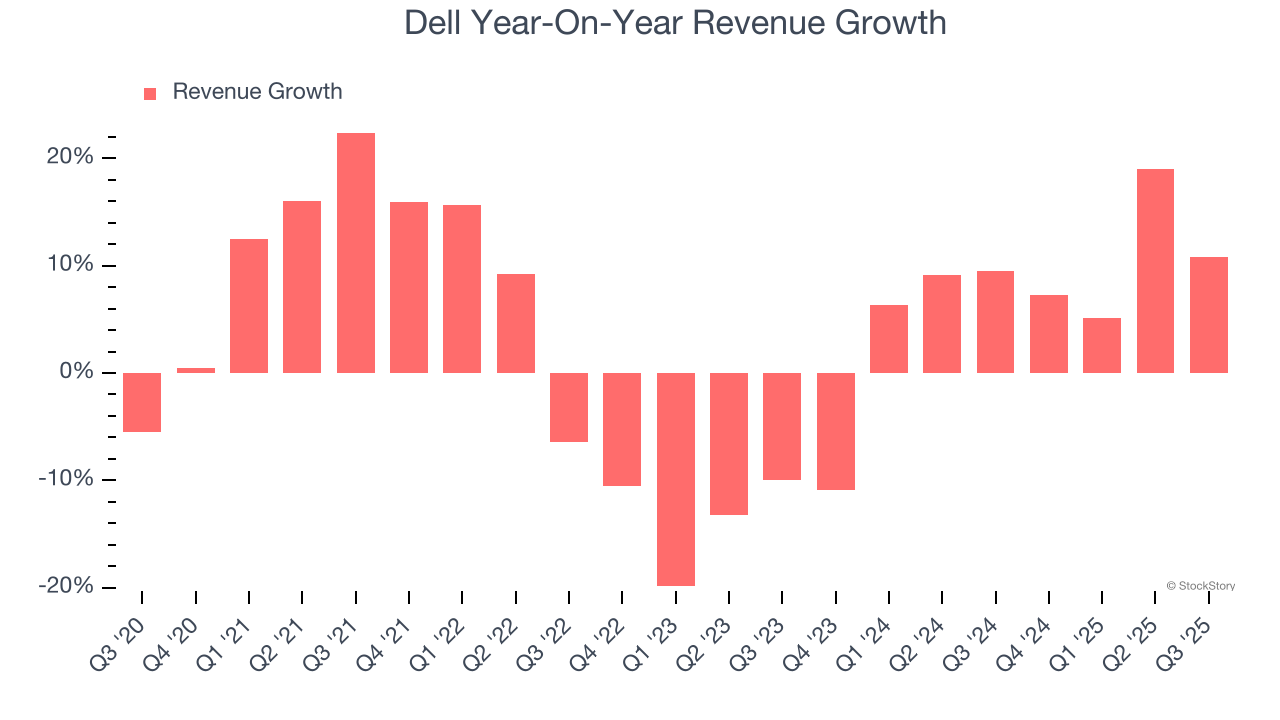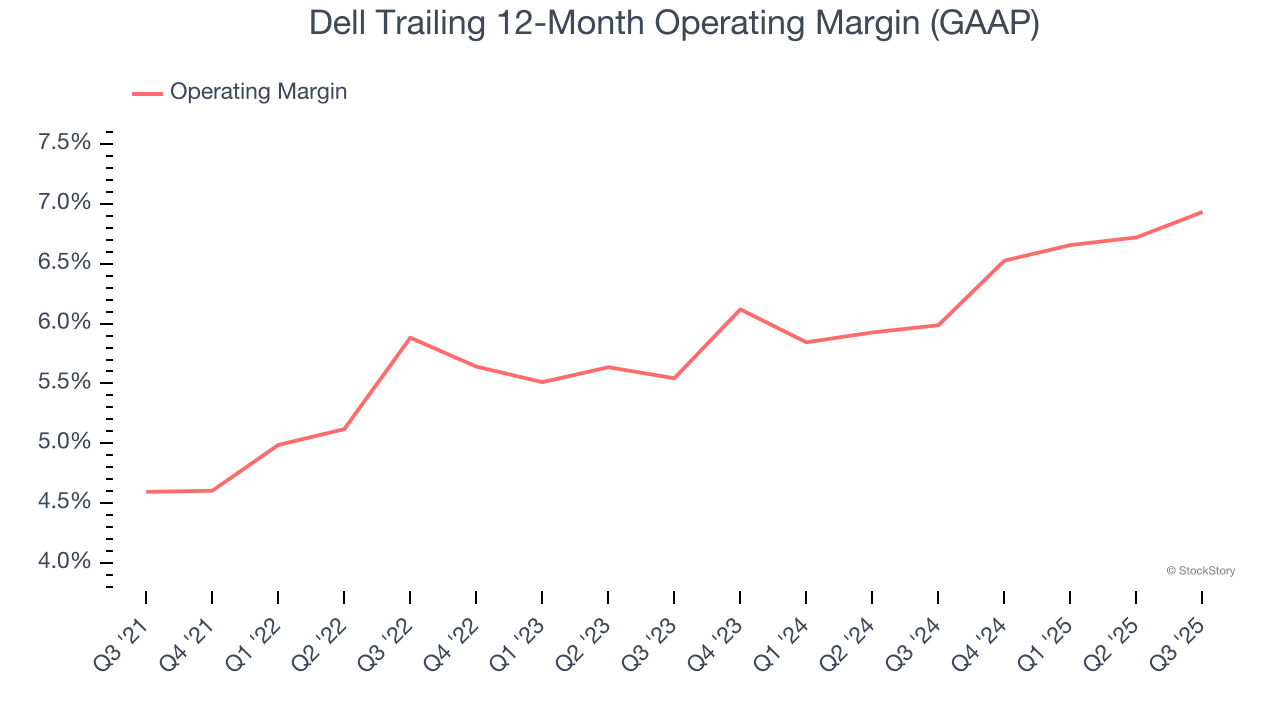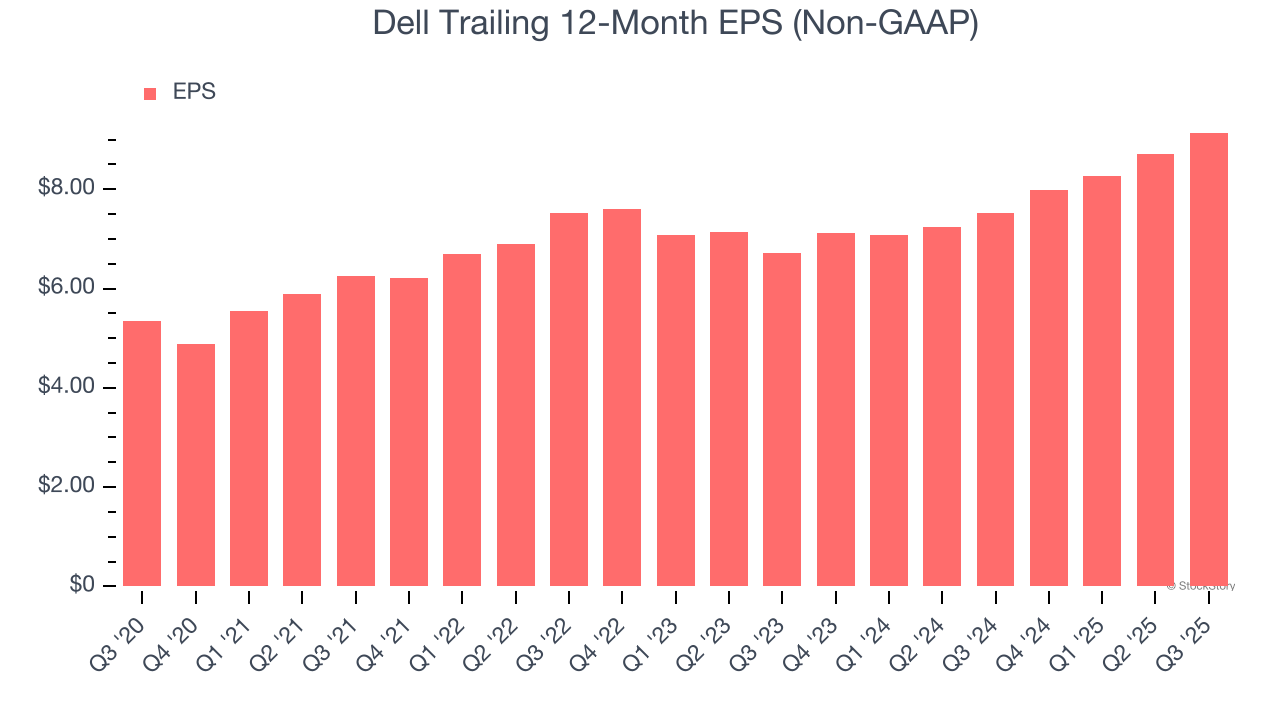
Computer hardware and IT solutions company Dell (NYSE: DELL) met Wall Streets revenue expectations in Q3 CY2025, with sales up 10.8% year on year to $27.01 billion. The company expects next quarter’s revenue to be around $31.5 billion, coming in 14.6% above analysts’ estimates. Its non-GAAP profit of $2.59 per share was 4.5% above analysts’ consensus estimates.
Is now the time to buy Dell? Find out by accessing our full research report, it’s free for active Edge members.
Dell (DELL) Q3 CY2025 Highlights:
- Revenue: $27.01 billion vs analyst estimates of $27.1 billion (10.8% year-on-year growth, in line)
- Adjusted EPS: $2.59 vs analyst estimates of $2.48 (4.5% beat)
- Revenue Guidance for Q4 CY2025 is $31.5 billion at the midpoint, above analyst estimates of $27.49 billion
- Management raised its full-year Adjusted EPS guidance to $9.92 at the midpoint, a 3.9% increase
- Operating Margin: 7.8%, in line with the same quarter last year
- Free Cash Flow Margin: 1.9%, down from 3.8% in the same quarter last year
- Market Capitalization: $85.26 billion
Company Overview
Founded by Michael Dell in his University of Texas dorm room in 1984 with just $1,000, Dell Technologies (NYSE: DELL) provides hardware, software, and services that help organizations build their IT infrastructure, manage cloud environments, and enable digital transformation.
Revenue Growth
A company’s long-term sales performance can indicate its overall quality. Any business can put up a good quarter or two, but the best consistently grow over the long haul.
With $104.1 billion in revenue over the past 12 months, Dell is a behemoth in the business services sector and benefits from economies of scale, giving it an edge in distribution. This also enables it to gain more leverage on its fixed costs than smaller competitors and the flexibility to offer lower prices. However, its scale is a double-edged sword because finding new avenues for growth becomes difficult when you already have a substantial market presence. To accelerate sales, Dell likely needs to optimize its pricing or lean into new offerings and international expansion.
As you can see below, Dell grew its sales at a tepid 3.8% compounded annual growth rate over the last five years. This shows it failed to generate demand in any major way and is a rough starting point for our analysis.

Long-term growth is the most important, but within business services, a half-decade historical view may miss new innovations or demand cycles. Dell’s annualized revenue growth of 6.9% over the last two years is above its five-year trend, suggesting some bright spots. 
This quarter, Dell’s year-on-year revenue growth was 10.8%, and its $27.01 billion of revenue was in line with Wall Street’s estimates. Company management is currently guiding for a 31.6% year-on-year increase in sales next quarter.
Looking further ahead, sell-side analysts expect revenue to grow 10.2% over the next 12 months, an improvement versus the last two years. This projection is particularly healthy for a company of its scale and implies its newer products and services will fuel better top-line performance.
While Wall Street chases Nvidia at all-time highs, an under-the-radar semiconductor supplier is dominating a critical AI component these giants can’t build without. Click here to access our free report one of our favorites growth stories.
Operating Margin
Operating margin is an important measure of profitability as it shows the portion of revenue left after accounting for all core expenses – everything from the cost of goods sold to advertising and wages. It’s also useful for comparing profitability across companies with different levels of debt and tax rates because it excludes interest and taxes.
Dell was profitable over the last five years but held back by its large cost base. Its average operating margin of 5.8% was weak for a business services business.
On the plus side, Dell’s operating margin rose by 2.3 percentage points over the last five years, as its sales growth gave it operating leverage.

In Q3, Dell generated an operating margin profit margin of 7.8%, in line with the same quarter last year. This indicates the company’s overall cost structure has been relatively stable.
Earnings Per Share
We track the long-term change in earnings per share (EPS) for the same reason as long-term revenue growth. Compared to revenue, however, EPS highlights whether a company’s growth is profitable.
Dell’s EPS grew at a remarkable 11.3% compounded annual growth rate over the last five years, higher than its 3.8% annualized revenue growth. This tells us the company became more profitable on a per-share basis as it expanded.

Diving into Dell’s quality of earnings can give us a better understanding of its performance. As we mentioned earlier, Dell’s operating margin was flat this quarter but expanded by 2.3 percentage points over the last five years. On top of that, its share count shrank by 34.2%. These are positive signs for shareholders because improving profitability and share buybacks turbocharge EPS growth relative to revenue growth. 
Like with revenue, we analyze EPS over a shorter period to see if we are missing a change in the business.
For Dell, its two-year annual EPS growth of 16.6% was higher than its five-year trend. We love it when earnings growth accelerates, especially when it accelerates off an already high base.
In Q3, Dell reported adjusted EPS of $2.59, up from $2.15 in the same quarter last year. This print beat analysts’ estimates by 4.5%. Over the next 12 months, Wall Street expects Dell’s full-year EPS of $9.14 to grow 18.4%.
Key Takeaways from Dell’s Q3 Results
We were impressed by how significantly Dell blew past analysts’ EPS guidance for next quarter expectations this quarter. We were also glad its revenue guidance for next quarter trumped Wall Street’s estimates. On the other hand, its revenue was in line. Zooming out, we think this was a solid print. The stock remained flat at $125.23 immediately following the results.
Is Dell an attractive investment opportunity at the current price? The latest quarter does matter, but not nearly as much as longer-term fundamentals and valuation, when deciding if the stock is a buy. We cover that in our actionable full research report which you can read here, it’s free for active Edge members.





